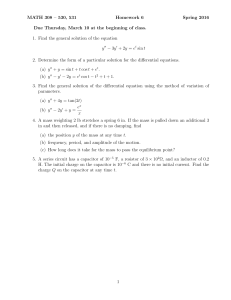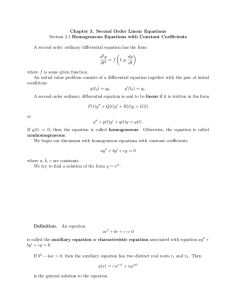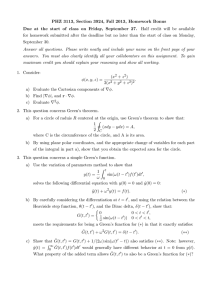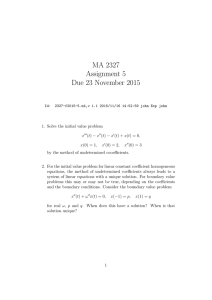Document 10842122
advertisement
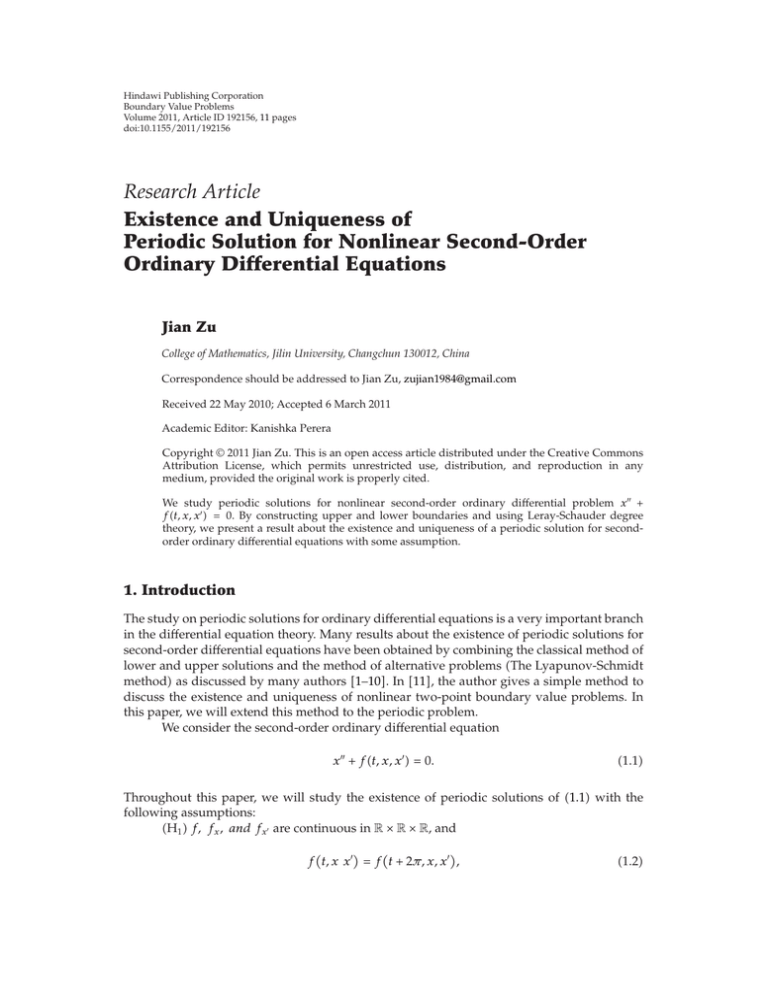
Hindawi Publishing Corporation
Boundary Value Problems
Volume 2011, Article ID 192156, 11 pages
doi:10.1155/2011/192156
Research Article
Existence and Uniqueness of
Periodic Solution for Nonlinear Second-Order
Ordinary Differential Equations
Jian Zu
College of Mathematics, Jilin University, Changchun 130012, China
Correspondence should be addressed to Jian Zu, zujian1984@gmail.com
Received 22 May 2010; Accepted 6 March 2011
Academic Editor: Kanishka Perera
Copyright q 2011 Jian Zu. This is an open access article distributed under the Creative Commons
Attribution License, which permits unrestricted use, distribution, and reproduction in any
medium, provided the original work is properly cited.
We study periodic solutions for nonlinear second-order ordinary differential problem x ft, x, x 0. By constructing upper and lower boundaries and using Leray-Schauder degree
theory, we present a result about the existence and uniqueness of a periodic solution for secondorder ordinary differential equations with some assumption.
1. Introduction
The study on periodic solutions for ordinary differential equations is a very important branch
in the differential equation theory. Many results about the existence of periodic solutions for
second-order differential equations have been obtained by combining the classical method of
lower and upper solutions and the method of alternative problems The Lyapunov-Schmidt
method as discussed by many authors 1–10. In 11, the author gives a simple method to
discuss the existence and uniqueness of nonlinear two-point boundary value problems. In
this paper, we will extend this method to the periodic problem.
We consider the second-order ordinary differential equation
x ft, x, x 0.
1.1
Throughout this paper, we will study the existence of periodic solutions of 1.1 with the
following assumptions:
H1 f, fx , and fx are continuous in R × R × R, and
f t, x x f t 2π, x, x ,
1.2
2
Boundary Value Problems
H2 γ2
≤ β < N 12 ,
4
π 4α − γ 2
γ2
sin
< 1−
if N > 0,
4N
4α
β
4N 1
,
γ<
1−
π
N 12
N2 < α −
1.3
where N is some positive integer,
α inf fx ,
R3
γ supfx .
β sup fx ,
R3
R3
1.4
The following is our main result.
Theorem 1.1. Assume that H1 and H2 hold, then 1.1 has a unique 2π-periodic solution.
2. Basic Lemmas
The following results will be used later.
Lemma 2.1 see 12. Let x ∈ C1 0, h, R h > 0 with
x0 xh 0,
for t ∈ 0, h,
2.1
x tdt,
2.2
xt > 0
then
h
xtx tdt ≤ h
4
0
h
2
0
and the constant h/4 is optimal.
Lemma 2.2 see 12. Let x ∈ C1 a, b, R a, b ∈ R, a < b with the boundary value conditions
xa xb 0, then
b
x2 tdt ≤
a
b − a2
π2
b
x tdt.
2
2.3
a
Consider the periodic boundary value problem
x ptx qtx 0,
x0 x2π,
x 0 x 2π.
2.4
Boundary Value Problems
3
Lemma 2.3. Suppose that p, q are L2 -integrable 2π-periodic function, where p, q satisfy the
condition (H2 ), with
α inf qt,
0,2π
γ sup pt,
β sup qt,
0,2π
0,2π
2.5
then 2.4 has only the trivial 2π-periodic solution xt ≡ 0.
Proof. If on the contrary, 2.4 has a nonzero 2π-periodic solution xt, then using 2.4, we
have
t
t
psds psds
e t0
x e t0
qtx 0,
2.6
where t0 ∈ 0, 2π is undetermined.
Firstly, we prove that xt has at least one zero in 0, 2π. If xt / 0, we may assume
xt > 0. Since xt is a 2π-periodic solution, there exists a t0 ∈ 0, 2π with x t0 0 x t0 2π. Then,
0
t0 2π e
t
psds x
t0
t0
dt −
t0 2π
t
e t0
psds
qtxdt < 0,
2.7
t0
we could get a contradiction.
Without loss of generality, we may assume that x0 x2π 0, x 0 x 2π A > 0; then there exists a sufficiently small δ > 0 such that xδ/2 > 0, x2π − δ/2 < 0. Since
xt is a continuous function, there must exist a t ∈ δ/2, 2π − δ/2 with xt 0.
Secondly, we prove that xt has at least 2N 2 zeros on 0, 2π. Considering the initial
value problem
ϕ − γϕ αϕ 0,
ϕ 0 A.
ϕ0 0,
2.8
Obviously,
2A
eγt/2 sin
ϕt 2
4α − γ
4α − γ 2
2
t
2.9
is the solution of 2.8 and
ϕ t 2A
⎞
⎛
2
4α
−
γ
α
⎟
⎜
t θ⎠,
eγt/2 sin⎝
2
4α − γ 2
2.10
4
Boundary Value Problems
where θ ∈ 0, π/2 with sin θ 4α − γ 2 /4α. Since
N<
4α − γ 2
2
2.11
<N1
holds under the assumptions of H2 , there is a t0 ∈ 0, π, such that
4α − γ 2
2
t0 θ π,
i.e.,
π
≤
2
4α − γ 2
2
2.12
t0 < π.
Now, let N > 0. By the conditions H2 , 2.11, and 2.12, we have
sin
4α − γ 2
2
t0 sin θ π
<
2
π
4α − γ
> sin
4α
2
4α − γ 2
4N
π
4α − γ 2
4N
2.13
,
2.14
< π.
Since sin t is decreasing in π/2, π , we have 0 < t0 < π/2N. Therefore,
ϕ t > 0,
ϕt > 0,
for t ∈ 0, t0 , ϕ t0 0.
2.15
We also consider the initial value problem
ψ γψ αψ 0,
ψ t0 0.
ψt0 ϕt0 ,
2.16
Clearly,
ψt 2
⎛
α
⎜
ϕt0 e−γt−t0 /2 sin⎝
4α − γ 2
4α − γ 2
2
⎞
⎟
t − t0 θ⎠
2.17
is the solution of 2.16, where θ is the same as the previous one, and
2α
ϕt0 e−γt−t0 /2 sin
ψ t − 2
4α − γ
4α − γ 2
2
t − t0 .
2.18
Hence, there exists a t1 ∈ 0, 2π with t1 − t0 ∈ 0, π, such that
4α − γ 2
2
t1 − t0 θ π.
2.19
Boundary Value Problems
5
Then,
ψt1 0.
2.20
From 2.12 and 2.19, it follows that
4α − γ 2
4
t1 π − θ,
i.e.,
π
≤
2
4α − γ 2
4
t1 < π.
2.21
By H2 and 2.21, we have
sin
4α − γ 2
4
t1 sin θ π 4α − γ 2
4α − γ 2
> sin
.
4α
4N
2.22
Since sin t is decreasing on π/2, π, we have 0 < t1 < π/N, and
ψ t < 0,
ψt > 0,
for t ∈ t0 , t1 .
2.23
We now prove that xt has a zero point in 0, t1 . If on the contrary xt > 0 for t ∈
0, t1 , then we would have the following inequalities:
xt ≤ ϕt,
for t ∈ 0, t0 ,
2.24
xt ≤ ψt,
for t ∈ t0 , t1 .
2.25
In fact, from2.4, 2.8, and 2.15, we have
ϕ txt − ϕtx t
ϕ txt ϕ tx t − ϕ tx t − ϕtx t
γϕ t − αϕt xt − ϕt −ptx t − qtxt
γ pt ϕ txt −pt ϕ txt − ϕtx t qt − α ϕtxt
≥ −pt ϕ txt − ϕtx t ,
2.26
with t ∈ 0, t0 . Setting y ϕ txt − ϕtx t, and since
y ≥ −pty,
2.27
we obtain
t
ye 0 psds
≥ 0,
t ∈ 0, t0 .
2.28
6
Boundary Value Problems
Notice that ϕ0 x0 0, which implies
y0 0,
t
ye 0 psds ≥ 0,
2.29
t ∈ 0, t0 .
So, we have
ϕ txt − ϕtx t ≥ 0,
t ∈ 0, t0 ,
i.e.,
ϕt
xt
≥ 0,
t ∈ 0, t0 .
2.30
Integrating from 0 to t ∈ 0, t0 , we obtain
0≤
t 0
ϕs
xs
ds ϕt ϕt ϕ 0
ϕt
− lim
−
.
xt t → 0 xt xt x 0
2.31
Therefore,
ϕt
≥ 1,
xt
t ∈ 0, t0 ,
2.32
which implies 2.24. By a similar argument, we have 2.25. Therefore, 0 < xt1 ≤ ψt1 0,
a contradiction, which shows that xt has at least one zero in 0, t1 , with t1 < π/N.
We let xt1 0, t1 ∈ 0, t1 . If t1 t1 < 2π, then from a similar argument, there is a
2
1 1
t ∈ t , t t1 , such that xt2 0 and so on. So, we obtain that xt has at least 2N 2 zeros
on 0, 2π.
Thirdly, we prove that xt has at least 2N 3 zeros on 0, 2π. If, on the contrary, we
assume that xt only has 2N 2 zeros on 0, 2π, we write them as
0 t0 < t1 < · · · < t2N1 2π.
2.33
Obviously,
0,
x ti /
i 0, 1, . . . , 2N 1.
2.34
Without loss of generality, we may assume that x t0 > 0. Since
x ti x ti1 < 0,
i 0, 1, . . . , 2N,
2.35
we obtain x t2N1 < 0, which contradicts x t2N1 x t0 > 0. Therefore, xt has at least
2N 3 zeros on 0, 2π.
Boundary Value Problems
7
Finally, we prove Lemma 2.3. Since xt has at least 2N 3 zeros on 0, 2π, there are
two zeros ξ1 and ξ2 with 0 < ξ2 − ξ1 ≤ π/N 1. By Lemmas 2.1 and 2.2, we have
ξ2
x tdt −
2
ξ2
ξ1
xtx tdt ξ2
ξ1
ptxtx tdt ξ2
ξ1
qtx2 tdt
ξ1
γ
β
≤
ξ2 − ξ1 2 ξ2 − ξ1 2
4
π
ξ2
2.36
2
x tdt.
ξ1
From H2 , it follows that
γ
β
πγ
β
< 1.
ξ2 − ξ1 2 ξ2 − ξ1 2 ≤
4
4N 1 N 12
π
2.37
Hence,
ξ2
x tdt 0,
2
2.38
ξ1
which implies x t 0 for t ∈ ξ1 , ξ2 . Also xξ1 0. Therefore, xt ≡ 0 for t ∈ 0, 2π, a
contradiction. The proof is complete.
3. Proof of Theorem 1.1
Firstly, we prove the existence of the solution. Consider the homotopy equation
x αx λ −f t, x, x αx ≡ λF t, x, x ,
3.1
where λ ∈ 0, 1 and α infR3 fx . When λ 1, it holds 1.1. We assume that Φt is the
fundamental solution matrix of x αx 0 with Φ0 I. Equation 3.1 can be transformed
into the integral equation
x
x
t Φt
x0
x 0
t
Φ s
0
0
−1
λFs, xs, x s
ds .
3.2
From H1 , xt is a 2π-periodic solution of 3.2, then
I − Φ2π
x0
x 0
Φ2π
2π
0
−1
Φ s
0
λFs, xs, x s
ds.
3.3
For I − Φ2π is invertible,
x0
x 0
−1
I − Φ2π Φ2π
2π
0
−1
Φ s
0
λFs, xs, x s
ds.
3.4
8
Boundary Value Problems
We substitute 3.4 into 3.2,
x
x
2π
−1
t ΦtI − Φ2π Φ2π
Φ s
Φt
Φ−1 s
ds
3.5
0
ds.
λFs, xs, x s
0
λFs, xs, x s
0
t
0
−1
Define an operator
3.6
Pλ : C1 0, 2π −→ C1 0, 2π,
such that
Pλ
x
x
−1
t ≡ ΦtI − Φ2π Φ2π
2π
−1
Φ s
λFs, xs, x s
0
Φt
t
0
−1
Φ s
0
λFs, xs, x s
0
ds
3.7
ds.
Clearly, Pλ is a completely continuous operator in C1 0, 2π.
There exists B > 0, such that every possible periodic solution xt satisfies x ≤ B · denote the usual normal in C1 0, 2π. If not, there exists λk → λ0 and the solution xk t with
xk → ∞ k → ∞.
We can rewrite 3.1 in the following form:
xk
1
αxk −λk
fx
0
t, xk , θxk
dθxk
− λk
1
fx t, θxk , 0dθxk − λk ft, 0, 0 λk αxk .
3.8
0
Let yk xk /xk t ∈ R, obviously yk 1 k 1, 2, . . .. It satisfies the following
problem:
yk αyk −λk
1
0
1
fx t, xk , θxk dθyk − λk 0 fx t, θxk , 0dθyk − λk ft, 0, 0/xk λk αyk ,
3.9
in which we have
ft, 0, 0
−→ 0
xk k −→ ∞.
3.10
Since {yk }, {yk } are uniformly bounded and equicontinuous, there exists continuous function
∞
ut, vt and a subsequence of {k}∞
1 denote it again by {k}1 , such that limk → ∞ yk t 1
∞
ut, limk → ∞ yk t vt uniformly in R. Using H1 and H2 , { 0 fx t, θxk , 0dθ}1 and
Boundary Value Problems
9
1
∞
{ 0 fx t, xk , θxk dθ}1 are uniformly bounded. By the Hahn-Banach theorem, there exists
∞
L2 -integrable function pt, qt, and a subsequence of {k}∞
1 denote it again by {k}1 , such
that
1
ω
fx t, θxk , 0dθ −→ qt,
1
0
ω
fx t, xk , θx k dθ −→ pt,
3.11
0
ω
where −→ denotes “weakly converges to” in L2 0, 2π. As a consequence, we have
u t αut −λ0 ptu t − λ0 qtut λ0 αut,
3.12
u t λ0 ptu t λ0 qt 1 − λ0 α ut 0.
3.13
that is,
Denote that pt λ0 pt, qt
λ0 qt 1 − λ0 α, then we get
pt λ0 pt ≤ γ,
λ0 α 1 − λ0 α ≤ qt
≤ λ0 β 1 − λ0 α,
3.14
which also satisfy the condition H2 . Notice that pt and qt
are L2 -integrable on 0, 2π, so
ut satisfies Lemma 2.3. Hence, we have ut ≡ 0 for t ∈ 0, 2π, which contradicts u 1.
Therefore, PC1 0, 2π is bounded.
Denote
Ω x ∈ C1 0, 2π, x < B 1 ,
3.15
hλ x x − Pλ x.
Because 0 ∈
/ hλ ∂Ω for λ ∈ 0, 1, by Leray-Schauder degree theory, we have
degx − P x, Ω, 0 degh1 x, Ω, 0 degh0 x, Ω, 0 / 0.
3.16
So, we conclude that P has at least one fixed point in Ω, that is, 1.1 has at least one solution.
Finally, we prove the uniqueness of the equation when the condition H1 and H2 holds. Let x1 t and x2 t be two 2π-periodic solutions of the problem. Denote x0 t x1 t −
x2 t, t ∈ 0, 2π, then x0 t is a solution of the following problem:
x 1
0
fx t, x2 x0 , x2 θx 0 dθx x0 x2π,
By Lemma 2.3, we have x0 t ≡ 0 for t ∈ 0, 2π.
1
0
fx t, x2 θx0 , x2 dθx 0,
x 0 x 2π.
3.17
10
Boundary Value Problems
Let xt
2kπ xt, t ∈ 0, 2π, k ∈ Z. We have
x t 2kπ x t −f t, x, x −f t, x,
x −f t 2kπ, x,
x ,
3.18
with t ∈ 0, 2π, k ∈ Z. Denote xt
2kπ t ∈ 0, 2π by xt t ∈ R. So, xt is the solution
of the problem 1.1. The proof is complete.
4. An Example
Consider the system
x 2
sin tx 6x cos x pt,
3
4.1
where pt pt 2π is a continuous function. Obviously,
α inf fx inf6 − sin x 5,
R3
R3
β sup fx sup6 − sin x 7,
R3
R3
2
2
γ sup fx sup sin t 3
3
R3
R3
4.2
satisfy Theorem 1.1, then there is a unique 2π-periodic solution in this system.
Acknowledgments
The author expresses sincere thanks to Professor Yong Li for useful discussion. He would like
to thank the reviewers for helpful comments on an earlier draft of this paper.
References
1 C. Bereanu and J. Mawhin, “Existence and multiplicity results for some nonlinear problems with
singular φ-Laplacian,” Journal of Differential Equations, vol. 243, no. 2, pp. 536–557, 2007.
2 J. Ehme, P. W. Eloe, and J. Henderson, “Upper and lower solution methods for fully nonlinear
boundary value problems,” Journal of Differential Equations, vol. 180, no. 1, pp. 51–64, 2002.
3 R. Kannan and V. Lakshmikantham, “Existence of periodic solutions of nonlinear boundary value
problems and the method of upper and lower solutions,” Applicable Analysis, vol. 17, no. 2, pp. 103–
113, 1983.
4 H.-W. Knobloch, “On the existence of periodic solutions for second order vector differential
equations,” Journal of Differential Equations, vol. 9, pp. 67–85, 1971.
5 H. W. Knobloch and K. Schmitt, “Non-linear boundary value problems for systems of differential
equations,” Proceedings of the Royal Society of Edinburgh. Section A, vol. 78, no. 1-2, pp. 139–159, 1977.
6 Y. Liu and W. Ge, “Positive periodic solutions of nonlinear Duffing equations with delay and variable
coefficients,” Tamsui Oxford Journal of Mathematical Sciences, vol. 20, no. 2, pp. 235–255, 2004.
7 R. Ortega and M. Tarallo, “Almost periodic upper and lower solutions,” Journal of Differential
Equations, vol. 193, no. 2, pp. 343–358, 2003.
Boundary Value Problems
11
8 I. Rachůnková and M. Tvrdý, “Existence results for impulsive second-order periodic problems,”
Nonlinear Analysis. Theory, Methods & Applications, vol. 59, no. 1-2, pp. 133–146, 2004.
9 K. Schmitt, “Periodic solutions of linear second order differential equations with deviating
argument,” Proceedings of the American Mathematical Society, vol. 26, pp. 282–285, 1970.
10 S. Sȩdziwy, “Nonlinear periodic boundary value problem for a second order ordinary differential
equation,” Nonlinear Analysis. Theory, Methods & Applications, vol. 32, no. 7, pp. 881–890, 1998.
11 Y. Li, “Boundary value problems for nonlinear ordinary differential equations,” Northeastern
Mathematical Journal, vol. 6, no. 3, pp. 297–302, 1990.
12 D. S. Mitrinović, Analytic Inequalities, Springer, New York, NY, USA, 1970.
